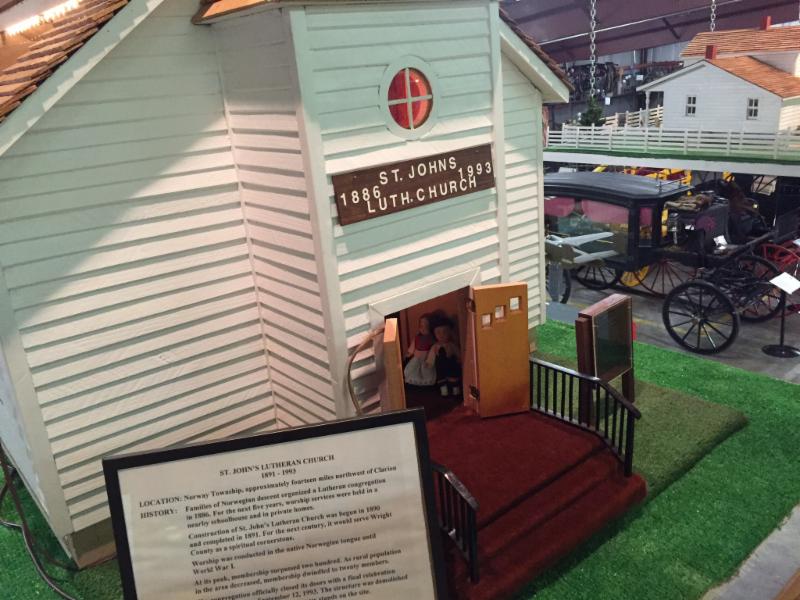
St. Johannnes (St. John’s) Lutheran Church 1886 - 1993 ---
Early Norwegian Church in Wright County, Iowa
by Mary
Tesdahl

|
Model of St. Johannnes (St. John’s) Lutheran Church in the Heartland Museum in Clarion, Iowa
When Wright County was first settled, one of the first groups to organize were
churches. Norway
township had many families of Norwegian
descent. Some came directly from
Norway and some had moved
here from
other counties or neighboring
states. In 1886, these
families formed
St. Johannnes (St. John’s) Lutheran Church. The address given was Drew, Iowa. In 1890, Lars Johnson donated an acre of land and the first church
building was built at a cost of $1,889.95.
Going to church in those early years required commitment, especially in the
winter when you traveled by sleigh or bobsled.
A sleigh could be pulled by a single horse; a bobsled needed a team. The bobsled could hold more people and was warmer. The driver would stand
at the front of the box or sit on a spring seat, but going was slow and it was
cold. In 1913, St. John’s built a
horse shed large enough for twenty horses.
The horses were driven into the
barn and tied to a manger to wait while the family attended church. If the horse was sweaty, it was covered with a blanket so it wouldn’t get
sick. If
it was exceptionally
cold or snowy,
services would be
cancelled. Other times of the year,
parishioners walked or rode in buggies.
Educating children was important
to these
early settlers as
was maintaining their
heritage. Sunday
school and Bible
school were
started in 1892.
Sunday school
was held every Sunday from
early spring until fall.
Many children walked or
came by
horse and buggy.
Bible school was a two month adventure.
Many ethnic churches used that extra time to
teach Norwegian
history, language, and culture.
School was in
English, but
these early settlers wanted
to be sure the children did not lose their heritage.
Because travel was so difficult, it made sense that Ladies Aid be an all day affair. Women quilted and sewed together. The proceeds from these projects were designated for mission work. The women
took great pride in their hand work and tiny exact stitches.
There was no day care so children were part of the activity.
The men might also come and spent the time in devotions and business of
the church. Bible study was eventually part of the day as well.
During these early years, services were in Norwegian.
During WWI, the use of any foreign language was discouraged and services
changed to English. Kerosene lamps
provided light. St. John’s had over
200 members at its height. As time
went on and farms became larger and distances traveled became less of an issue,
membership at St. John’s declined.
It was no longer able to fulfill its mission and closed its doors in 1993. These early churches played a crucial role in helping these early
settlers assimilate to their new land while continuing to have ties to the
homeland they left.
|
Page Online: March 2017